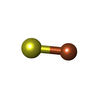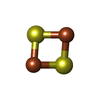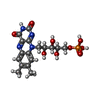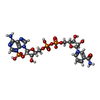[English] 日本語
 Yorodumi
Yorodumi- EMDB-15212: Cryo-EM structure of the electron bifurcating Fe-Fe hydrogenase H... -
+ Open data
Open data
- Basic information
Basic information
| Entry |  | |||||||||||||||||||||
|---|---|---|---|---|---|---|---|---|---|---|---|---|---|---|---|---|---|---|---|---|---|---|
| Title | Cryo-EM structure of the electron bifurcating Fe-Fe hydrogenase HydABC complex from Thermoanaerobacter kivui in the reduced state | |||||||||||||||||||||
 Map data Map data | Cryo-EM structure of the electron bifurcating Fe-Fe hydrogenase HydABC complex from Thermoanaerobacter kivui in the reduced state. | |||||||||||||||||||||
 Sample Sample |
| |||||||||||||||||||||
| Function / homology |  Function and homology information Function and homology informationhydrogen dehydrogenase (NADP+) / hydrogen dehydrogenase (NADP+) activity / cellular anatomical entity / ferredoxin hydrogenase activity / ATP synthesis coupled electron transport / NADH dehydrogenase (ubiquinone) activity / 2 iron, 2 sulfur cluster binding / FMN binding / 4 iron, 4 sulfur cluster binding / iron ion binding ...hydrogen dehydrogenase (NADP+) / hydrogen dehydrogenase (NADP+) activity / cellular anatomical entity / ferredoxin hydrogenase activity / ATP synthesis coupled electron transport / NADH dehydrogenase (ubiquinone) activity / 2 iron, 2 sulfur cluster binding / FMN binding / 4 iron, 4 sulfur cluster binding / iron ion binding / membrane / metal ion binding Similarity search - Function | |||||||||||||||||||||
| Biological species |   Thermoanaerobacter kivui (bacteria) Thermoanaerobacter kivui (bacteria) | |||||||||||||||||||||
| Method | single particle reconstruction / cryo EM / Resolution: 3.1 Å | |||||||||||||||||||||
 Authors Authors | Kumar A / Saura P / Gamiz-Hernandez AP / Kaila VRI / Mueller V / Schuller JM | |||||||||||||||||||||
| Funding support |  Germany, European Union, Germany, European Union,  Sweden, 6 items Sweden, 6 items
| |||||||||||||||||||||
 Citation Citation |  Journal: J Am Chem Soc / Year: 2023 Journal: J Am Chem Soc / Year: 2023Title: Molecular Basis of the Electron Bifurcation Mechanism in the [FeFe]-Hydrogenase Complex HydABC. Authors: Alexander Katsyv / Anuj Kumar / Patricia Saura / Maximilian C Pöverlein / Sven A Freibert / Sven T Stripp / Surbhi Jain / Ana P Gamiz-Hernandez / Ville R I Kaila / Volker Müller / Jan M Schuller /   Abstract: Electron bifurcation is a fundamental energy coupling mechanism widespread in microorganisms that thrive under anoxic conditions. These organisms employ hydrogen to reduce CO, but the molecular ...Electron bifurcation is a fundamental energy coupling mechanism widespread in microorganisms that thrive under anoxic conditions. These organisms employ hydrogen to reduce CO, but the molecular mechanisms have remained enigmatic. The key enzyme responsible for powering these thermodynamically challenging reactions is the electron-bifurcating [FeFe]-hydrogenase HydABC that reduces low-potential ferredoxins (Fd) by oxidizing hydrogen gas (H). By combining single-particle cryo-electron microscopy (cryoEM) under catalytic turnover conditions with site-directed mutagenesis experiments, functional studies, infrared spectroscopy, and molecular simulations, we show that HydABC from the acetogenic bacteria and employ a single flavin mononucleotide (FMN) cofactor to establish electron transfer pathways to the NAD(P) and Fd reduction sites by a mechanism that is fundamentally different from classical flavin-based electron bifurcation enzymes. By modulation of the NAD(P) binding affinity via reduction of a nearby iron-sulfur cluster, HydABC switches between the exergonic NAD(P) reduction and endergonic Fd reduction modes. Our combined findings suggest that the conformational dynamics establish a redox-driven kinetic gate that prevents the backflow of the electrons from the Fd reduction branch toward the FMN site, providing a basis for understanding general mechanistic principles of electron-bifurcating hydrogenases. | |||||||||||||||||||||
| History |
|
- Structure visualization
Structure visualization
| Supplemental images |
|---|
- Downloads & links
Downloads & links
-EMDB archive
| Map data |  emd_15212.map.gz emd_15212.map.gz | 41.8 MB |  EMDB map data format EMDB map data format | |
|---|---|---|---|---|
| Header (meta data) |  emd-15212-v30.xml emd-15212-v30.xml emd-15212.xml emd-15212.xml | 20.1 KB 20.1 KB | Display Display |  EMDB header EMDB header |
| Images |  emd_15212.png emd_15212.png | 105.2 KB | ||
| Others |  emd_15212_half_map_1.map.gz emd_15212_half_map_1.map.gz emd_15212_half_map_2.map.gz emd_15212_half_map_2.map.gz | 77.6 MB 77.6 MB | ||
| Archive directory |  http://ftp.pdbj.org/pub/emdb/structures/EMD-15212 http://ftp.pdbj.org/pub/emdb/structures/EMD-15212 ftp://ftp.pdbj.org/pub/emdb/structures/EMD-15212 ftp://ftp.pdbj.org/pub/emdb/structures/EMD-15212 | HTTPS FTP |
-Validation report
| Summary document |  emd_15212_validation.pdf.gz emd_15212_validation.pdf.gz | 714.1 KB | Display |  EMDB validaton report EMDB validaton report |
|---|---|---|---|---|
| Full document |  emd_15212_full_validation.pdf.gz emd_15212_full_validation.pdf.gz | 713.7 KB | Display | |
| Data in XML |  emd_15212_validation.xml.gz emd_15212_validation.xml.gz | 12.7 KB | Display | |
| Data in CIF |  emd_15212_validation.cif.gz emd_15212_validation.cif.gz | 14.9 KB | Display | |
| Arichive directory |  https://ftp.pdbj.org/pub/emdb/validation_reports/EMD-15212 https://ftp.pdbj.org/pub/emdb/validation_reports/EMD-15212 ftp://ftp.pdbj.org/pub/emdb/validation_reports/EMD-15212 ftp://ftp.pdbj.org/pub/emdb/validation_reports/EMD-15212 | HTTPS FTP |
-Related structure data
| Related structure data |  8a6tMC  7q4vC  7q4wC  8a5eC  8bewC M: atomic model generated by this map C: citing same article ( |
|---|---|
| Similar structure data | Similarity search - Function & homology  F&H Search F&H Search |
- Links
Links
| EMDB pages |  EMDB (EBI/PDBe) / EMDB (EBI/PDBe) /  EMDataResource EMDataResource |
|---|---|
| Related items in Molecule of the Month |
- Map
Map
| File |  Download / File: emd_15212.map.gz / Format: CCP4 / Size: 83.7 MB / Type: IMAGE STORED AS FLOATING POINT NUMBER (4 BYTES) Download / File: emd_15212.map.gz / Format: CCP4 / Size: 83.7 MB / Type: IMAGE STORED AS FLOATING POINT NUMBER (4 BYTES) | ||||||||||||||||||||
|---|---|---|---|---|---|---|---|---|---|---|---|---|---|---|---|---|---|---|---|---|---|
| Annotation | Cryo-EM structure of the electron bifurcating Fe-Fe hydrogenase HydABC complex from Thermoanaerobacter kivui in the reduced state. | ||||||||||||||||||||
| Voxel size | X=Y=Z: 0.87 Å | ||||||||||||||||||||
| Density |
| ||||||||||||||||||||
| Symmetry | Space group: 1 | ||||||||||||||||||||
| Details | EMDB XML:
|
-Supplemental data
-Half map: Half-map B
| File | emd_15212_half_map_1.map | ||||||||||||
|---|---|---|---|---|---|---|---|---|---|---|---|---|---|
| Annotation | Half-map B | ||||||||||||
| Projections & Slices |
| ||||||||||||
| Density Histograms |
-Half map: Half-map A
| File | emd_15212_half_map_2.map | ||||||||||||
|---|---|---|---|---|---|---|---|---|---|---|---|---|---|
| Annotation | Half-map A | ||||||||||||
| Projections & Slices |
| ||||||||||||
| Density Histograms |
- Sample components
Sample components
+Entire : Electron bifurcating Fe-Fe hydrogenase HydABC complex from Thermo...
+Supramolecule #1: Electron bifurcating Fe-Fe hydrogenase HydABC complex from Thermo...
+Macromolecule #1: Electron bifurcating hydrogenase subunit HydA1
+Macromolecule #2: Electron bifurcating hydrogenase subunit HydB
+Macromolecule #3: Electron bifurcating hydrogenase subunit HydC
+Macromolecule #4: IRON/SULFUR CLUSTER
+Macromolecule #5: 2 IRON/2 SULFUR/5 CARBONYL/2 WATER INORGANIC CLUSTER
+Macromolecule #6: FE2/S2 (INORGANIC) CLUSTER
+Macromolecule #7: FLAVIN MONONUCLEOTIDE
+Macromolecule #8: ZINC ION
+Macromolecule #9: NADP NICOTINAMIDE-ADENINE-DINUCLEOTIDE PHOSPHATE
-Experimental details
-Structure determination
| Method | cryo EM |
|---|---|
 Processing Processing | single particle reconstruction |
| Aggregation state | particle |
- Sample preparation
Sample preparation
| Buffer | pH: 7.6 |
|---|---|
| Vitrification | Cryogen name: ETHANE-PROPANE |
- Electron microscopy
Electron microscopy
| Microscope | JEOL CRYO ARM 200 |
|---|---|
| Image recording | Film or detector model: GATAN K2 SUMMIT (4k x 4k) / Average electron dose: 50.0 e/Å2 |
| Electron beam | Acceleration voltage: 200 kV / Electron source:  FIELD EMISSION GUN FIELD EMISSION GUN |
| Electron optics | Illumination mode: FLOOD BEAM / Imaging mode: BRIGHT FIELD / Nominal defocus max: 2.0 µm / Nominal defocus min: 0.8 µm |
- Image processing
Image processing
| Final reconstruction | Resolution.type: BY AUTHOR / Resolution: 3.1 Å / Resolution method: FSC 0.143 CUT-OFF / Number images used: 193719 |
|---|---|
| Initial angle assignment | Type: PROJECTION MATCHING |
| Final angle assignment | Type: PROJECTION MATCHING |
 Movie
Movie Controller
Controller

















 Z
Z Y
Y X
X






















